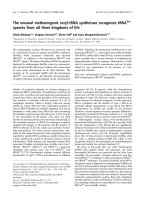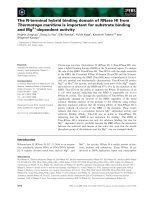Báo cáo khoa học: "The GENIA project: corpus-based knowledge acquisition and information extraction from genome research papers" docx
Bạn đang xem bản rút gọn của tài liệu. Xem và tải ngay bản đầy đủ của tài liệu tại đây (186.12 KB, 2 trang )
Proceedings of EACL '99
The GENIA project: corpus-based knowledge acquisition and
information extraction from genome research papers
Nigel Collier, Hyun Seok Park, Norihiro
Ogata
Yuka Tateishi, Chikashi Nobata, Tomoko Ohta
Tateshi
Sekimizu, Hisao Imai, Katsutoshi Ibushi, Jun-ichi
Tsujii
{nigel ,hsp20, ogat a,yucca, nova, okap ,sekimizu,hisao ,k-ibushi, tsuj ii}~£s, s .u-tokyo. ac. jp
Department of Information Science, Graduate School of Science
University of Tokyo, Hongo 7-3-1, Bunkyo-ku, Tokyo 113, Japan
Abstract
We present an outline of the genome in-
formation acquisition (GENIA) project
for automatically extracting biochemical
information from journal papers and ab-
stracts. GENIA will be available over
the Internet and is designed to aid in
information extraction, retrieval and vi-
sualisation and to help reduce informa-
tion overload on researchers. The vast
repository of papers available online in
databases such as MEDLINE is a natu-
ral environment in which to develop lan-
guage engineering methods and tools and
is an opportunity to show how language
engineering can play a key role on the
Internet.
1 Introduction
In the context of the global research effort to map
the human genome, the Genome Informatics Ex-
traction project, GENIA (GENIA, 1999), aims to
support such research by automatically extract-
ing information from biochemical papers and their
abstracts such as those available from MEDLINE
(MEDLINE, 1999) written by domain specialists.
The vast repository of research papers which are
the results of genome research are a natural envi-
ronment in which to develop language engineering
tools and methods.
This project aims to help reduce the problems
caused by information overload on the researchers
who want to access the information held inside
collections such as MEDLINE. The key elements
of the project are centered around the tasks of
information extraction and retrieval. These are
outlined below and then the interface which inte-
grates them is described.
1.1 Terminology identification and
classification
Through discussions with domain experts, we
have identified several classes of useful entities
such as the names of proteins and genes. The re-
liable identification and acquisition of such class
members is one of our key goals so that terminol-
ogy databases can be automatically extended. We
should not however underestimate the difficulty of
this task as the naming conventions in this field
are very loose.
In our initial experiments we used the EN-
GCG shallow parser (Voutilainen, 1996) to iden-
tify noun phrases and classify them as proteins
(Sekimizu et al., 1998) according to their cooc-
currence with a set of verbs. Due to the difficul-
ties caused by inconsistent naming of terms, we
have decided to use multiple sources of evidence
for classifying terminology.
Currently we have extended our approach and
are exploring two models for named entity recog-
nition. The first is based on a statistical model
of word clustering (Baker and McCallum, 1998)
which is trained on pre-classified word lists from
Swissprot and other databases. We supplemented
this with short word lists to identify the class from
a term's final noun if it existed in a head final po-
sition. In our first experiments on a judgement
set of 80 expert tagged MEDLINE abstracts the
model yielded F-scores for pre-identified phrases
as follows: 69.35 for 1372 source entities, 53.00 for
3280 proteins, 66.67 for 56 RNA and 45.20 for 566
DNA: We expect this to improve with the addi-
tion of better training word lists. The second ap-
proach is based on decision trees (Quinlan, 1993),
supplemented with word lists for classes derived
from Swissprot and other databases. In these tests
the phrases for terms were not pre-identified. The
model was trained on a corpus of 60 expert tagged
MEDLINE abstracts and tested on a corpus of 20
articles yielding F-scores of: 55.38 for 356 source,
66.58 for 808 protein entities. The number of RNA
271
Proceedings of EACL '99
and DNA entities was too small to train with.
As part of the overall project we are creating
an expert-tagged corpus of MEDLINE abstracts
and full papers for training and testing our tools.
The markup scheme for this corpus is being de-
veloped in cooperation with groups of biologists
and is based on a conceptual domain model imple-
mented in SGML. The corpus itself will be cross-
validated with an independent group of biologists.
1.2 Information extraction
We are using information extraction methods to
automatically extract named entity properties,
events and other domain-specific concepts from
MEDLINE abstracts and full texts. One part of
this work is the construction and maintenance of
an ontology for the domain which is executed by
a system which we are now developing called
On-
tology Extraction-Maintenace System (OEMS).
OEMS
extracts three types of information about
the domain-ontology, (Ogata, 1997), called
typ-
ing information,
from the abstracts:
taxonomy
(a
subtype structure),
mereology
(a part-whole struc-
ture),
synonymy
(an identity structure). Eventu-
ally we hope to be able to identify and extract do-
main specific facts such as protein-protein binding
information from full texts and to aid biochemists
in the formation of cell signalling diagrams which
are necessary for their work.
1.3 Thesaurus building
A further goal of our work is to construct a the-
saurus automatically from MEDLINE abstracts
and domain dictionaries consisting of medical do-
main terms for the purpose of query expansion in
information retrieval of databases such as MED-
LINE, e.g. see (Jing and Croft, 1994). We
are currently working with the Med test set (30
queries and 1033 documents) on SMART (e.g. see
(Salton, 1989),(Buckley et al., 1993)). Eventually
we plan on building a specialised thesaurus for the
genome domain but this currently depends on the
creation of a suitable test set.
1.4
Interface
A key aspect of this project is providing easy inter-
action between domain experts and the informa-
tion extraction programs. Our interface provides
a link to the information extraction programs as
well as clickable links to aid in querying for related
information from publically available databases on
the WWW within a single environment. For ex-
ample, a user can highlight proteins in the texts
using the named entity extraction program and
then search for the molecule structure diagram.
2 Conclusion
This paper has provided a synopsis of the GENIA
project. The project will run for a further two
years and aims to provide an online demonstration
of how language engineering can be useful in the
genome domain.
References
L.D. Baker and A.K. McCallum. 1998. Distribu-
tional clustering of words for text classification.
In
Proceedings of the 21st Annual International
ACM SIGIR Conference on Research and De-
velopment in Information Retrieval, Melbourne,
Australia.
C. Buckley, J. Allan, and G. Salton. 1993.
Automatic routing and ad-hoc retrieval using
SMART: TREC-2. In D. K. Harman, editor,
The second Text REtrieval Conference (TREC-
2), pages 45-55. NIST.
GENIA. 1999. Information on the GENIA
project can be found at:. .s.u-
tokyo.ac.jp/-nigel/GENIA.html.
Y. Jing and W. Croft. 1994. An association the-
saurus for information retrieval. In
Proceedings
of RIAO'94,
pages 146-160.
MEDLINE. 1999. The PubMed
database can be found at:.
Norihiro Ogata. 1997. Dynamic constructive
thesaurus. In
Language Study and Thesaurus:
Proceedings of the National Language Research
Institute Fifth International Symposium: Ses-
sion I,
pages 182-189. The National Language
Research Institute, Tokyo.
J.R. Quinlan. 1993.
c4.5 Programs for Machine
Learning.
Morgan Kaufmann Publishers, Inc.,
San Mateo, California.
G. Salton. 1989.
Automatic Text Processing- The
Transformation, Analysis, and Retrieval of In-
formation by Computer.
Addison-Wesley Pub-
lishing Company, Inc., Reading, Massachusetts.
T. Sekimizu, H. Park, and J. Tsujii. 1998. Iden-
tifying the interaction between genes and gene
products based on frequently seen verbs in med-
line abstracts. In
Genome Informatics.
Unvier-
sal Academy Press, Inc.
A. Voutilainen. 1996. Designing a (finite-state)
parsing grammar. In E. Roche and Y. Sch-
abes, editors,
Finite-Slate Language Processing.
A Bradford Book, The MIT Press.
272









